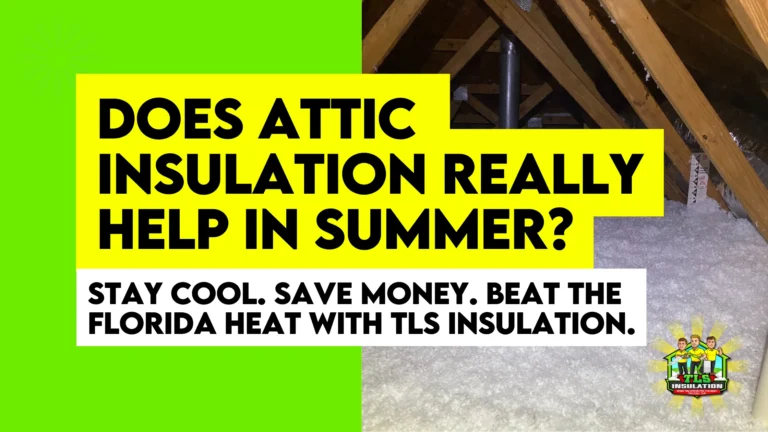Summer heat in Florida can be relentless, and the attic is often where the problem begins. As the roof absorbs the sun’s rays, heat builds up and pushes into the living areas below. Without the right protection, this raises indoor temperatures and makes cooling systems work much harder.
Proper attic insulation creates a thermal barrier that slows down heat transfer and helps homes stay cooler even on the hottest days. From years of working in Florida homes and based on our learning, we’ve seen how insulation not only improves comfort but also lowers energy costs and extends the life of air conditioning equipment.
Why Florida Homes Depend on Attic Insulation in Summer
Florida’s hot climate makes attic insulation one of the most important defenses against rising temperatures inside the home. The roof absorbs the sun’s heat throughout the day, and without a proper thermal barrier, that heat transfers directly into living spaces. We’ve seen how this extra heat forces air conditioning equipment to run longer, driving up energy bills and putting stress on HVAC systems. Quality attic insulation reduces heat flow, improves energy efficiency, and helps maintain cooler indoor conditions.
It also supports better ventilation by working with airflow to limit moisture buildup, which protects against mold and structural damage. Whether it’s fiberglass, cellulose insulation, spray foam, or reflective insulation, the right insulation material provides lasting protection against Florida’s intense summer heat. From our experience, homes with strong insulation perform better, cost less to cool, and offer more consistent comfort during the hottest months of the year.
Benefits of Attic Insulation During Summer
Lower Cooling Costs and Improved Energy Efficiency
One of the biggest benefits of attic insulation is the reduction in cooling expenses. By creating a thermal barrier, insulation slows down heat transfer from the roof into the home. This keeps indoor temperatures more stable and allows the air conditioner to cycle less often.
Over time, this lowers energy bills and reduces overall heat loss. We’ve seen how fiberglass batt, spray foam, and cellulose insulation each contribute to stronger efficiency, depending on the design of the home. Better energy efficiency means not only saving money but also extending the lifespan of air conditioning equipment.
More Comfortable Indoor Temperatures
Proper insulation for attic spaces helps maintain steady temperatures throughout the home, even during peak summer heat. Without insulation, upper floors and bedrooms often feel warmer due to rising heat. With a reliable insulation R-value, homeowners notice fewer hot spots and a cooler indoor environment.
This consistent comfort also reduces strain on HVAC systems because the cooling demand is spread more evenly. From our work with different insulation materials, we’ve found that creating an energy-efficient thermal barrier is one of the most effective ways to keep Florida homes comfortable in summer.
Moisture and Ventilation Control
Heat and humidity are constant challenges in Florida, and attic insulation plays a key role in managing both. When paired with proper ventilation, insulation helps reduce moisture buildup that can lead to mold, mildew, or structural damage. Materials like cellulose insulation and spray foam work especially well at maintaining balanced airflow and limiting condensation in attics.
By slowing heat flow, insulation also helps reduce the extreme temperature differences that often cause moisture issues. From our experience, homes with properly installed insulation and ventilation perform better and maintain healthier, longer-lasting roof structures.
Extending the Life of Cooling Systems
Attic insulation not only improves comfort but also protects the home’s air conditioning system. Without insulation, heat enters quickly, forcing the HVAC unit to run harder and longer. This overuse leads to more frequent repairs and a shorter lifespan for air conditioning equipment. Insulation reduces heat flow, helping the system operate more efficiently while keeping energy use under control.
Over the years, we’ve seen how homes with strong attic insulation require fewer HVAC replacements and offer more reliable cooling. This benefit makes insulation an investment that continues to pay off through lower maintenance and longer system life.
Types of Insulation for Attics in Summer
Fiberglass Attic Insulation
Fiberglass attic insulation is one of the most common options we install in Florida homes. It’s typically available as fiberglass batt or loose-fill, providing solid thermal protection against summer heat. This material is lightweight, affordable, and effective at slowing heat transfer through the roof. While it doesn’t create an air seal on its own, when properly installed, it significantly improves energy efficiency. Fiberglass insulation remains a reliable choice for homeowners seeking a balance between cost, performance, and long-lasting comfort.
Spray Foam Insulation
Spray foam insulation is highly effective because it not only provides strong thermal protection but also seals air leaks in the attic. This dual performance helps reduce heat flow, moisture issues, and outside air infiltration. With a high insulation R-value, spray foam works especially well in Florida’s hot climate by keeping homes cooler and lowering strain on HVAC systems. Although the upfront cost is higher, many homeowners find that spray foam’s energy savings and durability make it one of the best long-term insulation materials for attics.
Cellulose Insulation
Cellulose insulation is made from recycled paper products treated for fire resistance, which makes it an eco-friendly choice for attics. Blown-in cellulose creates dense coverage, filling small gaps and providing effective thermal protection during the hottest summer months. It also improves efficiency by reducing heat flow and helping air conditioning equipment run more efficiently. Cellulose insulation is also known for its sound-dampening qualities, which add to indoor comfort. For homeowners who want an environmentally friendly insulation material with reliable performance, cellulose is a smart option.
Reflective Insulation and Radiant Barriers
Reflective insulation and radiant barriers are designed specifically to combat the sun’s heat in attics. By using foil-backed materials, they reflect radiant energy away from the roof surface before it can enter the home. This reduces overall heat gain and keeps living spaces cooler without overworking the air conditioning system. While reflective insulation alone may not replace fiberglass or spray foam, it works well as an added layer of thermal protection. In Florida’s sunny climate, radiant barriers are a valuable upgrade that enhances overall insulation performance.
How to Insulate an Attic for Summer Performance
Choose the Right Insulation Material: Selecting between fiberglass, cellulose, spray foam, or reflective insulation depends on your budget and climate needs. Each insulation material offers different levels of thermal protection, efficiency, and durability. The best results come from matching the insulation R-value with the home’s summer performance requirements.
Seal Air Leaks and Gaps: Even the best insulation won’t perform well if the attic has leaks. Small cracks around ducts, vents, or framing allow hot air to enter and conditioned air to escape. Sealing these gaps improves energy efficiency and helps insulation provide consistent thermal protection during summer.
Install Attic Door Insulation: The attic door is often overlooked, yet it can be a major source of heat transfer. Adding proper attic door insulation prevents hot air from entering living areas and keeps cooler air inside. This small upgrade has a noticeable effect on energy savings and comfort.
Ensure Proper Ventilation: Balanced ventilation works hand in hand with attic insulation by allowing trapped heat and moisture to escape. Ridge vents, soffit vents, or fans help regulate airflow. Without ventilation, insulation may lose efficiency and moisture problems can develop, especially in Florida’s humid climate.
Best Attic Insulation for Florida Homes
Florida’s hot and humid summers require insulation that can handle constant exposure to high temperatures while keeping cooling costs under control. From our years of experience, fiberglass attic insulation remains one of the best options for homeowners who want reliable performance without overspending. It is available as batts or blown-in loose-fill, both of which deliver solid thermal protection by slowing down heat transfer through the roof.
Fiberglass insulation is also durable, non-combustible, and resistant to moisture damage when installed properly. These qualities make it a smart choice for attics, where the goal is to keep indoor spaces cooler and reduce the load on air conditioning equipment. Homeowners appreciate how fiberglass offers a balance of comfort, energy efficiency, and affordability.
Our team has installed fiberglass insulation in countless Florida homes, and we’ve seen firsthand how it improves summer comfort and lowers monthly energy bills. While other materials like spray foam or cellulose have their benefits, fiberglass continues to be the most trusted and cost-effective solution for this region. For homeowners looking to upgrade their attic insulation, fiberglass remains the best combination of value, durability, and long-term results.
Conclusion
Attic insulation remains one of the most effective ways to keep a Florida home comfortable through the summer heat. By slowing down heat transfer and controlling moisture, it keeps living spaces cooler while easing the load on air conditioning systems. From our experience, the right insulation lowers energy bills and makes a clear difference in everyday comfort. Whether you are replacing old insulation or considering an upgrade, the material you choose will shape long-term performance. With our professional home insulation services, we help homeowners create cooler, more energy-efficient spaces that last year after year.
Frequently Asked Questions
Will insulation keep a house cool in summer?
Yes, insulation helps keep a house cooler by slowing down heat transfer from the roof into the living space. It acts as a thermal barrier, allowing the air conditioner to maintain steady indoor temperatures with less effort. Homes with proper attic insulation stay noticeably more comfortable in summer.
Does attic insulation help with AC?
Attic insulation reduces the workload on air conditioning equipment by keeping cool air inside and blocking hot air from entering. This means the system doesn’t have to run as often, which saves energy, lowers utility bills, and extends the life of the HVAC unit.
What is the best attic insulation for hot weather?
In hot climates like Florida, fiberglass attic insulation is one of the most reliable and cost-effective options. It offers strong thermal protection, is moisture resistant, and helps reduce cooling costs. Spray foam and radiant barriers can also be effective, but fiberglass remains a trusted standard for attics.
How do I cool my attic in summer?
Cooling an attic requires a combination of insulation, ventilation, and sealing air leaks. Insulation slows heat transfer, while ridge and soffit vents improve airflow. Sealing gaps prevents conditioned air from escaping. Together, these steps reduce attic heat and help keep the entire home cooler.
Can a hot attic make a house hot?
Yes, a hot attic directly affects indoor comfort. When the roof absorbs the sun’s heat, it radiates into the attic and seeps into living spaces below. Without proper insulation, the air conditioner must work harder, which increases cooling costs and still leaves rooms feeling warmer.
Why do attic rooms get so hot?
Attic rooms are closer to the roof, where the sun’s heat is most intense. Poor insulation, inadequate ventilation, and air leaks allow that heat to build up. As a result, attic rooms often feel warmer than the rest of the house, especially during peak summer afternoons.

